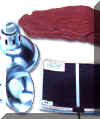|
An ordinary incandescent light bulb is the easiest way to heat the vivarium. This can give out considerable heat, but to be effective it needs to be on all the time, which is not good as the occupants will be in permanent light if they are to be kept warm.
A better option, which also mimics the natural increase in daytime temperature in the wild, is to have a background heat source (such as a heat mat) and a small spotlight within the vivarium to create a warm place for basking. At night the lamp can be turned off allowing the enclosure to cool down to some extent while the background heat output is maintained. The spot light will be more effective if it is a reflector, but avoid over heating the occupants of the vivaria. wild, is to have a background heat source (such as a heat mat) and a small spotlight within the vivarium to create a warm place for basking. At night the lamp can be turned off allowing the enclosure to cool down to some extent while the background heat output is maintained. The spot light will be more effective if it is a reflector, but avoid over heating the occupants of the vivaria.
There should always be a thermal gradient in the vivarium, which will allow the occupants to bask when they need to increase their body temperature and be able to cool down at the other end.
A thermostat should be used so that you can make sure that the occupants of the vivarium do not get to hot or to cold. The thermostat should be attached to the background heat source (normally a heat mat) so that the bulb can stay on to mimic daylight.
For some herps such as gecko's heat sources should be shielded by wire mesh so they cannot climb on the bulb and burn themselves.
Water can be heated using a 'heaterstat' as used for aquaria, this must stay submerged at all times.
|